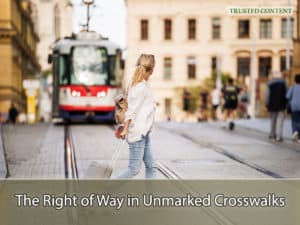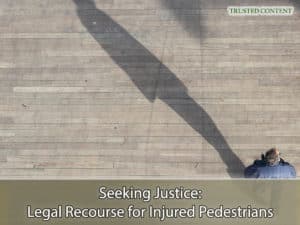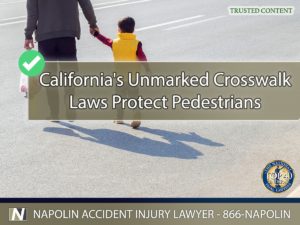How California’s Unmarked Crosswalk Laws Protect Pedestrians
In the bustling streets of California, the presence of unmarked crosswalks poses a unique challenge to both pedestrians and drivers. Unlike their marked counterparts, these crosswalks lack the visual cues that signal pedestrian pathways across roads. Despite this, California law provides clear protections for pedestrians, ensuring their safety and right of way. This article explores the nuances of these laws, offering valuable insights for navigating these invisible yet crucial pedestrian zones.
Understanding Unmarked Crosswalks
Definition and Location
An unmarked crosswalk is essentially an extension of sidewalks, trails, or any pedestrian pathways across roads at intersections, where no explicit markings are present. These crossings are integral to urban and suburban infrastructure, facilitating pedestrian movement across streets where marked crosswalks are not available. Despite their lack of visibility, unmarked crosswalks are legally recognized spaces intended for pedestrian use, underscoring the importance of understanding their role in traffic dynamics.
Legal Obligations
The interaction between pedestrians and drivers in unmarked crosswalks is governed by specific legal obligations. Pedestrians have the right of way in these crossings, a rule that mandates drivers to yield and ensure safe passage. However, this right is not absolute; pedestrians are also required to exercise caution and not recklessly step into traffic. This mutual responsibility aims to prevent accidents and ensure the safety of all road users.

The Right of Way in Unmarked Crosswalks
The Right of Way in Unmarked Crosswalks
California's vehicular code clearly states that pedestrians have the right of way in both marked and unmarked crosswalks. This legislation is designed to protect pedestrians, recognizing their vulnerability compared to motor vehicles. Drivers are required to reduce speed, stop if necessary, and proceed only when it is safe to do so, thereby preventing potential accidents. This law reflects California's commitment to pedestrian safety, emphasizing the state's prioritization of human life over traffic flow.
Pedestrian Safety and Due Care
California's Legal Framework
The concept of “due care” plays a pivotal role in ensuring pedestrian safety in unmarked crosswalks. This legal principle requires pedestrians to avoid entering traffic dangerously and to make prudent decisions when navigating crossings. The law acknowledges that while pedestrians have the right of way, they also bear a responsibility to not compromise their safety or that of others. This balanced approach fosters a safer environment for everyone on the road.
Safety Tips
For pedestrians, safety in unmarked crosswalks can be enhanced by following a few practical tips. Making eye contact with approaching drivers, assessing vehicle speed and distance, and waiting for a safe gap in traffic are crucial steps before crossing. Additionally, pedestrians should remain alert and avoid distractions, such as mobile devices, to better react to sudden traffic changes. These proactive measures significantly reduce the risk of accidents and ensure a safer crossing experience.
When Accidents Happen: Pedestrian Collisions in Unmarked Crosswalks
Accidents in unmarked crosswalks can present complex legal challenges, particularly in determining fault and liability. In such instances, the collection of evidence becomes paramount. Witnesses who observed the incident, security or traffic camera footage capturing the moment of collision, and official police reports are invaluable resources. These pieces of evidence can help clarify the circumstances of the accident, contributing to a fair and just resolution of personal injury claims.

Seeking Justice- Legal Recourse for Injured Pedestrians
Seeking Justice: Legal Recourse for Injured Pedestrians
Pedestrians injured in unmarked crosswalk accidents have several legal avenues to pursue justice and compensation. Immediate steps include seeking medical attention and documenting the incident comprehensively. Gathering evidence, such as medical records, witness contacts, and any available video footage, is crucial. A personal injury claim, facilitated by experienced legal representation, can help victims recover damages for medical expenses, lost wages, and pain and suffering. Legal experts specializing in pedestrian accidents can navigate the complexities of the claim process, advocating for the victim's rights and best interests.
Napolin Accident Injury Lawyer: Your Advocate in Unmarked Crosswalk Cases
Napolin Accident Injury Lawyer stands as a dedicated advocate for individuals injured in unmarked crosswalk incidents. Our expertise encompasses a deep understanding of California's pedestrian laws and a commitment to securing justice for our clients. With a comprehensive approach to legal representation, we strive to ensure that our clients receive the maximum compensation possible, reflecting the physical, emotional, and financial toll of their injuries.

How California's Unmarked Crosswalk Laws Protect Pedestrians
How California's Unmarked Crosswalk Laws Protect Pedestrians
The laws surrounding California's unmarked crosswalks are designed with pedestrian safety in mind, emphasizing the shared responsibility between pedestrians and drivers to prevent accidents. For those who have suffered injuries in such incidents, it's crucial to understand your rights and the legal protections available. Napolin Accident Injury Lawyer offers expert legal guidance and representation to navigate the aftermath of unmarked crosswalk accidents. If you or a loved one has been injured, contact us at (866)-NAPOLIN for a free consultation. Our extensive litigation experience ensures that your case is in capable hands, guiding you towards the compensation and justice you deserve.
- Safely and Legally Navigating Parking Lots in California - July 15, 2024
- Navigating the Aftermath of a Highway Auto Accident in California - July 15, 2024
- An Overview of California's Commercial Truck Insurance Laws - July 15, 2024
